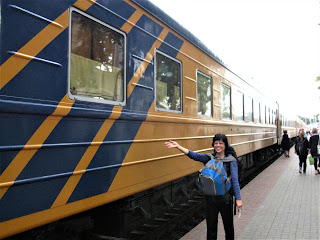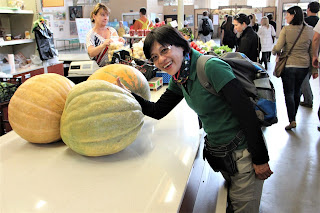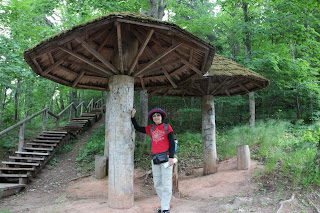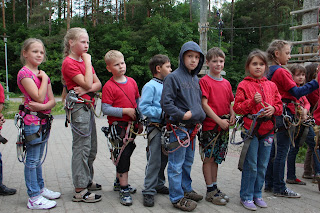A peep of the 3 Baltic states in 2011
Part 1/3
(Travel Story Series @ Hon Too Fang 2021)
We were part of a 4-people team to tour western Russia and the Baltic states of Latvia, Lithuania and Estonia in May 2011. This is the travel story in the 3 small countries.
1 - The Baltic states
After seeing Moscow we went west to tour Latvia, Lithuania and Estonia, 3 small countries east of the Baltic Sea, hence they are called the Baltic states. They are independent countries with similar topography and weather. Members of the European Union. One thing is common: all of them have a chequered past in terms of politics, mostly ruled by external powers throughout history, by Poland, Sweden, Germany, Russia, etc.
Each country has her own language but English is usable in tourist areas. In term of religion, they are rather different: Estonia is predominantly Protestant (Lutheran), Lithuania is Catholic and Latvia has equally sizable followers of Catholics, Protestants and Russian Orthodox. But we must remember nowadays in Europe, only 1 adult out of 4 believes in an organised religion. The atheists outnumber everybody.
(Note in 2021: the population of these 3 countries are declining, mostly due to easy migration to other western European countries in the European Union. Greener pasture is in the west. The worst case is Lithuania, with a population loss of about 1% each year. Her current population is only about 75% of that in 1991 when she had her independence.)
2 - Cold Baltic and warm "Balticians"
These countries are colder as they are more to the north. In fact Estonia is just a short strait away from Finland. But the people are warmer and helpful to the tourists. If you are holding a city map looking lost at a street corner, you can expect some locals coming forward to ask you if you need help. But then tourism is big business in these countries, unlike Russia with the least-helpful Russians.
3 – Holding hands works
The Baltic states are small countries. The people were abused by the big neighbours all the time. Their most hated enemies were (and are) the Nazi Germans and Communist Russians. They became part of the Soviet Union in 1941. On August 23, 1989, 2 million people in these 3 Baltic states joined hands to form a human chain over a 600 km line across the 3 countries in a peaceful demonstration asking for independence from the communist Soviet Union. They had their independence a few years later.
4 – Asian food in the Baltic states
About 10 days into our trip (starting from Moscow in Russia) we saw for the first time a Chinese restaurant, in Kaunas, Lithuania. So NL and the 2 of us went for lunch in this Peking Restaurant. Very fanciful menu and a lot of choices. We ordered 4 dishes: a pork, a chicken, a mixed vegetable and a soup. The chicken ordered is a distinctive dish (宫保鸡丁) where the small boneless chicken pieces are fried with a lot of big onion and cashew nuts and dried chilli. Couldn't remember what pork dish we have ordered. But when the dishes came the same gravy was used for all the meat and vegetable dishes, that familiar sweet-n-sour gravy. We certainly did not order cooking in sweet-n-sour style. After we finished the dishes we still didn't know which plate was pork and which plate was chicken. The 3 plates tasted the same.
We made a mild laughing complaint to the chef. The Chinese chef explained to us that the "white people" like the dishes this way. What else to say? He also reminded us that the next time we were in a Chinese restaurant in this part of the World, do tell the waiter that we were ethnic Chinese and wanted the dishes cooked the real Chinese way.
Several days later we were in Tallinn in Estonia and walked past another Chinese restaurant. The smartly-dressed young man at the entrance, most likely the boss, engaged us in some conversation in Mandarin and plainly told us not to eat there. We wouldn't like it, he said. He thought we came from mainland China.
We did have a very good nasi briyani dinner in an Indian restaurant in Vilnius in Lithuania. Authentic, you could smell the aroma of curry when you enter the restaurant. Only about twice more expensive than a similar plate from a mamak restaurant in PJ.
5 - Taxi service
In the Baltic states, because public transport is so efficient, there are not many taxis in service, except at the central train stations or bus stations. Certainly not on the street. In fact we took taxi only a few times on this tour.
In Vilnius, Lithuania we were cheated by a taxi driver. After our greatly satisfying nasi briyani dinner described in the previous section we decided to take a taxi from the old town back to the hostel. It was already 10 pm. The 1+ km journey cost us about RM 30. The "real" fare would not be more than RM 10. The trip meter continued jumping faster than my wife's heart-beat, she said. It had to be a "faulty" meter, diplomatically speaking. We chose not to argue but paid up. We didn't want to spoil the good evening. Secondly and more importantly: the driver was 6 foot 6, weighed more than the 3 of us combined.
6 - Espresso and soya sauce
I like coffee and usually order cappuccino during a sit-down meal on this trip. But our friend NL seldom drinks coffee. At home he drinks Chinese tea. During one of the meals we had together, he did the unthinkable: order an espresso with his chicken chop.
The main dish came, together with a small cup half filled with a black liquid. NL took a small sip, made his face and wanted to dip a piece of his chicken chop in the cup, saying,
"Not bad lah, this restaurant, got soya sauce even!"
"Aiya, NL, that must be the espresso you order one lah, not soya sauce!"
"Ya ka? But why so bitter one? And so little only?"
"But that is espresso loh. It tastes like that one!"
Believe it or not, NL the 71 year-old, has not drunk espresso for a long while and forgotten about the taste. Normal coffee yes, and cappuccino once in a while. But he is not your typical Chinaman uncle or a Chinese frog at the bottom of a well. He is a giraffe above the canopy - seen them all. He has travelled to more countries in the World than most of you readers here. He was stung by the most poisonous travel bug some 15 years ago and has continued to travel the World to look for the antidote. NL has gone to more than 60 or 70 countries in the World, wrote a book on his travel in Alaska, been to China more than 20 times and set foot on all the continents, including Antarctica. He is booked to go to the North Pole in 2013 at a cost of RM 100,000. Sh...sh....sh... Don't tell the wife: he told her RM 20K only.
7 - Moscow to Riga
From Moscow we took a 16-hour night train to Riga in Latvia. We were in Class 2 Deluxe, 4 sleeping berths in a private cabin. And the train fare was about RM 800 each. One way. Terribly expensive. Tickets booked online while in Malaysia.
The air fare from Moscow to Riga was about RM 560 one way. ??? Why like that one? Pay more to take the train, wasting 16 hours? Actually we just followed our leader GW, the budget traveller from Hong Kong. He originally intended to buy the Class 3 (sitting) ticket for the train journey, which would be around RM 300+, much cheaper than the air fare. So train was chosen. But we richer fragile senior citizens how to sit in a crammed train for 16 hours? So we 3 booked the luxurious sleeping berths. Finally GW also bought the Class 2 Ordinary, with sleeping berth but in a dorm, at around RM 500.
So we were not getting the best deal by blindly following the leader. Isn't this the same situation the ordinary BN follower is getting?
The 3 of us in a cabin meant for 4 people, so our luggage has a bed too. Quite spacious. With NL and his big foot.
8 - What to see in the Baltic states
These are smaller versions of the countries we commonly refer to as Eastern Europe: Hungary, Poland, Slovakia, etc. Cost of living is lower. Nothing spectacular in terms of tourist attractions. Except may be the Hill of Crosses near Siauliai in north Lithuania, 1st photo.
We visited several small museums with niche themes. In the Museum of Devils we visited in Kaunas, Lithuania, the 2 most prominent devils (in effigy of course) were Hitler and Stalin. Both were truly demonised. The image of Hitler and Stalin skipping in an area with human bones was shot from a poster. And to football fans the effigy of the Red Devil, the Manchester United logo, was exhibited too.
---------- Now start touring ----------
9 – Riga, the capital of Latvia
Latvia is a nation about 3 times the size of our Perak state, with 2.1 million people, 60% Latvians and 27% Russians.
Riga is the capital and a transport hub, with about 650,000 people. It generates more than 50% of the country’s GDP. Shown panoramic views of the city centre. The Vansu River runs through the city.
Central Market
The Central Market, open in 1930, is one of the oldest and largest markets in Europe. It consists of 5 pavilions constructed by reusing old aircraft hangers. It is located outside the old town. It, together with the old town, form a UNESCO World Heritage site.
Old Town
The old town, is a heritage site famous for some historic buildings. The most famous is the House of Blackheads at the Town Hall Square, built in 1334 and later owned by a club for bachelors, called the Blackheads. Not sure why called "blackheads", may be if you remain single, no wife trouble, you won't have white hair! Too late to know for me. The present building was reconstructed after WW2. The statue at the centre of the square is that of Roland, an 8th century legendary German knight said to be a symbol of fairness.
Other notable buildings are the Town Hall, 1st photo and the Three Brothers, 2nd photo. The Three Brothers are 3 adjacent medieval Baroque buildings erected in the 1500s. Only 2 buildings are shown in the photo, I missed out the ugly 3rd by mistake during shooting.
Art Nouveau buildings
Art Nouveau is an international ornamental art form, used in architecture and interior decoration, involving long lines like the sinuous curves of plants and flowers, and exhibiting the dynamism of movement. The peak period was around 1890 and 1910. Riga is the Art Nouveau of Europe. There are 2 streets with many such buildings.
Museum of Medical History
We visited a niche museum, called the Museum of Medical History. Shown an African shaman figurine to treat sickness used in ancient times, an old dentist’s chair and an eye chart for the illiterate, still used not too long ago.
Latvian War Museum
We also visited another niche museum housed in the red Powder Tower and the next building with a “cute” decoration. The Powder Tower, 1st photo, was built in 1650. The exhibits are related to the military and political history of the country.
Freedom Monument
This was erected in 1930 to honour the soldiers killed in the 1st Latvian War of Independence (1918-20). The 42 m monument is topped with a statue of a woman holding 3 stars representing freedom for 3 regions in Latvia.
The Dome Cathedral
This is the Lutheran cathedral in Riga, the official name being the Cathedral Church of St Mary. It is the largest religious building in the city. The 1st version was built in 1211, last renovated in 1881-1914.
St James’ Cathedral
This is a Catholic cathedral first built in 1225. During the Protestant Reformation it was used as a Lutheran church, starting 1522. Finally given back to the Catholics in 1923.
Statues and decorations
The old town centre is well decorated with flowers.

And “cool” statues. The 1st one is called “Peace Dance” created in 1970. The last one is the most famous because of the political overture. It is called “Musicians of Bremen” where a donkey, a dog, a cat and a rooster were seen peeping out of their iron curtain representing the Soviet Union.
10 – Sigulda, a small town in Latvia
We spent a day visiting the towns of Sigulda and Cesis. This small town of Sigulda is about 55 km north east of Riga. It has a national park and an historical reserve. We spent a few hours hiking in the national park, two of us. The forest trail was rather deserted. Our activity included taking a chair lift to the top of a low but steep hill.
Stopped at some ruins and met a group of well-equipped youngsters ready for adventure. The wild flower is called rugged robin. The last photo shows the ground of a rest area paved with small tree stumps. Unique and cool!
Turaida Castle
The partly restored castle is located on the opposite bank of the Gauja River with Sigulda. The original castle was built in 1214 and abandoned in 1776 after a fire. There is a small museum inside the castle.

Folk Song Hill
Nearby is the Folk Song Hill with a sculpture park dedicated to Latvian folklore. Shown 3 of the more than 30 sculptures: the 1st is called “Father of Folk Songs” and the 2nd is “Three Young Sisters”. Plus a beautiful building.
11 - Cesis, another small town in Latvia
Cesis is another small town 35 km northeast of Sigulda. This town is famous for its well-kept medieval buildings and the Cesis Castle dated to the 1200s. The statue in the 3rd photo is the famous “Old Man of Time” and the monument is the Victory Monument to honour the soldiers killed the war of independence in 1920.
Cesis Castle
The castle was first built in 1209 meant for a German knight. Ownership changed hands several times in the course of history. It was destroyed in a war in 1709 and the victor chose to build a new castle nearby. It was abandoned thereafter. While going down to the basement we were given a medieval lantern for illumination, last photo.

St John’s church
The church was built in 1284 by the Catholics, now owned by the Lutherans. It is a big church for a small town, 65 m long, 32 m wide, with a tower 65 m high. There were many rounds of rebuilding for the church. The tower was added only in 1853. It is a Gothic design, with the massive buttress shown in the 1st photo.
---------- End of tour in Latvia, next Lithuania ----------





































































No comments:
Post a Comment